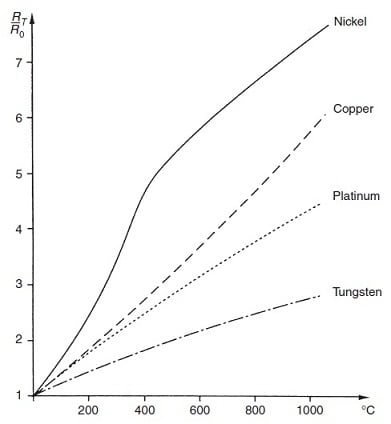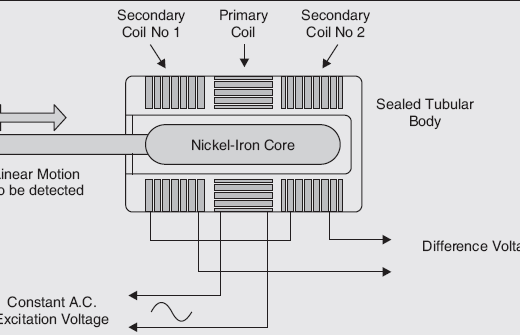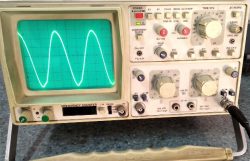Table of Contents
Resistance Thermometers
Resistance Thermometer: The resistance of a conductor changes when its temperature is changes. This property is utilized for the measurement of temperature. The resistance thermometer is an instrument used to measure electrical resistance in terms of temperature, i.e. it uses the electrical resistance of the conductor to determine the temperature.
Definition: Resistance thermometers, which are alternatively known as resistance temperature devices (or RTDs), rely on the principle that the resistance of a metal varies with temperature according to the
R_{T}=R_{0}(1+\alpha _{1}T+\alpha _{2}T^{2}+...+\alpha _{n}T^{n})
where R is the resistance at T = 0.
For engineering purposes and also if the range of variation in temperature is narrow then
R_{T}=R_{0}(1+\alpha\Delta t)
where α is the temperature coefficient at to and Ro is the resistance at to.
For large temperature ranges, the resistance equation follows the equation form more accurately
R_{T}=R_{0}(1+\alpha\Delta t+\beta \Delta t^{2})
Principle of Resistance Thermometers
It has been observed that the “resistance” of metals increases with increase in temperature. Therefore metals are said to have a positive temperature co-efficient of resistivity. However, some semiconductor materials have a negative temperature coefficient of resistivity. That means their resistance decreases with increase in temperature. Thus it is possible to convert the temperature variations into equivalent change in resistance.
This is the principle of operation of resistance type temperature sensors. These transducers are called as “Resistance Temperature Detectors (RTD) or Resistance Thermometers.”
- The resistance thermometer measures electrical resistance in terms of temperature.
- The main element of the resistance thermometer is its sensing element. The sensing material is material that possesses a large resistance with change in temperature.
- The sensing element determines the sensitivity and the operating temperature range of the instrument.
- The conductor material that is used should be stable in characteristics. Stability is essential in order to maintain the calibration of the resistance thermometer. But, it limits the temperature over which the conductor material can be used.
Conductive elements used in thermometers are
- Platinum.
- Nickel.
- Copper.
- Tungsten.
- Nickel/iron alloys.
Some important points about materials used
- Platinum has the most linear resistance/temperature characteristic and also has good chemical inertness.
- It is therefore far more common than copper or nickel thermocouples.
- Its resistance–temperature relationship is linear within ±0.4% over the temperature range between -200 and +40o C. Even at +1000oC, the quoted inaccuracy figure is only ±1.2%.
- Platinum thermometers are made in three forms, as a film deposited on a ceramic substrate, as a coil mounted inside a glass or ceramic probe, or as a coil wound on a mandrel, although the last of these are now becoming rare.
- The nominal resistance at 0oC is typically 100 or 1000 Ω, although 200 and 500 Ω versions also exist. Sensitivity is 0.385 Ω/oC (100 Ω type) or 3.85 Ω/OC (1000 Ωtype).
- A high nominal resistance is advantageous in terms of higher measurement sensitivity, and the resistance of connecting leads has less effect on measurement accuracy. However, cost goes up as the nominal resistance increases.
- In addition to having a less linear characteristic, both nickel and copper are inferior to platinum in terms of their greater susceptibility to oxidation and corrosion.
- This seriously limits their accuracy and longevity. However, because platinum is very expensive compared to nickel and copper, the latter are used in resistance thermometers when cost is important.
- Another metal, tungsten, is also used in resistance thermometers in some circumstances, particularly for high temperature measurements.
The working ranges of each of these four types of resistance thermometers are as shown here:
- Platinum: -270 to +1000oC (although use above 650oC is uncommon)
- Copper: -200 to +260oC
- Nickel: -200 to +430oC
- Tungsten: -270 to +1100oC
Characteristics of materials used for Resistance Thermometers in Table Form
| Metal | Resistance temperature Coefficient /oC | Minimum Temperature Range oC | Maximum Temperature Range oC | Advantage | Disadvantage |
| Platinum | 0.39 | -260 | 1100 | 1. Low Cost 2. High stability 3. Wide operating range | 1. Slow response 2. Nonlinear as copper thermometers |
| Copper | 0.39 | 0 | 180 | 1. High linearity 2. High accuracy in ambient temperature range 3. High stability | 1. Limited temperature range |
| Nickel | 0.62 | -220 | 300 | 1. Long life 2. High sensitivity 3. High temperature coefficient | 1. More non-linear than copper 2. Limited temperature range |
| Tungsten | 0.45 | -200 | 1000 | 1. High resistivity | 1. Extremely brittle and difficult to work |
Construction of RTD:
The figure is shows below the simplest type of open-wire construction of Platinum Resistance Thermometer (PRT). The platinum wire is wound in the form of spirals on an insulating material such as mica or ceramic. This assembly is fired at high temperature to assure annealing of the winding.
This assembly is then placed at the tip of probe as shown in figure below. This wire is in direct contact with the gas or liquid whose temperature is to be measured. This gas or liquid however should not be corrosive or conductive.
- The resistance of the platinum wire changes with change in temperature of the gas or liquid. The maximum temperature measurable in continuous operation is 1000° K i.e. 727°C.
- This type of sensors has a positive temperature coefficient of resistivity as they are made from metals. These are also known as “resistance temperature detectors or RTD. The other metals used are nickel and copper.
- For many applications the platinum resistance wire is enclosed in a protective tube. The tube is made of glass, quartz, porcelain or metal. This protects the resistance wire from any mechanical damage or chemical reaction.
- Resistance thermometers are generally of probe type for immersion in medium whose temperature is to be measured or controlled.
- The probe is protected by a sheath to produce the complete sensing element.
- The changes in resistance caused by changes in temperature are detected by a Wheatstone bridge, as shown in figure below.
- The sensing element is made up of conducting material that has a high temperature coefficient. The resistances R1, R2, and R5 are generally constant under normal temperature changes.
- When the bridge is balanced, i.e. no current flows through the galvanometer then the ratio of resistances is
\frac{R_{1}}{R_{2}}=\frac{R_{s}}{R_{5}}
In normal practice, the sensing element is away from the indicator and the bridge, and its leads have a resistance, say R3, R4.
\frac{R_{1}}{R_{2}}=\frac{R_{3}+R_{s}+R_{4}}{R_{5}}
When resistance Rs changes, the bridge balance cannot be maintained. The galvanometer shows a deflection, which can be calibrated to give a suitable temperature scale.
Advantages of Resistance Thermometers
- They can be used for the measurement of small as well as large temperature differences.
- Its measurement has a high accuracy.
- The measurement has a high reproducibility.
- RTD’s have a good dynamic response because it responds very quickly to the changes in temperature.
- The resistance thermometers are best suited for remote indication.
Disadvantages
- A resistance thermometer has a large size and large volume as compared to thermocouples.
- Resistance Thermometers are very costly than a thermocouple.
- They need external DC power supply source.
- They need a bridge circuit and a power source.
- It has a possibility of Self-heating and thermoelectric effect of the resistive element and connecting leads (dissimilar metal junctions) cause errors.







